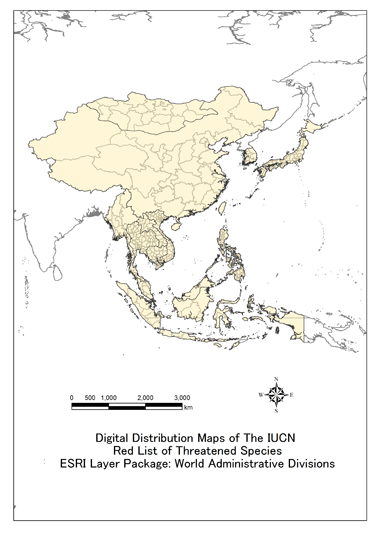
TOP > 生物多様性センターの国際協力 > ESABII > Database > Threatened Mammal Species Database > Phalanger alexandrae

Phalanger alexandrae
Taxonomy (Name)
| Class | MAMMALIAIUCN | |
|---|---|---|
| Order | DIPROTODONTIAIUCN | |
| Family | PHALANGERIDAEIUCN | |
| Scientific Name | Phalanger alexandraeIUCN | |
| Author | Flannery & Boeadi, 1995IUCN | |
| Synonyms | ||
| Common Name | Gebe CuscusIUCN | |
| Local name | Brunei Darussalam | |
| Cambodia | ||
| China | ||
| Indonesia | Kuskus (semua jenis dari genus Phalanger) | |
| Japan | ||
| Lao PDR | ||
| Malaysia | ||
| Myanmar | ||
| Mongolia | ||
| Philippines | ||
| Singapore | ||
| Republic of Korea | ||
| Thailand | ||
| Vietnam | ||
Picture
Distribution, Range
This species is endemic to Indonesia, where it has been reported from Sangihe (the largest island in the Sangihe Island group) and Salibabu (within the Talaud Islands). However, although a bear cuscus has been seen and photographed on Sangihe, no specimen from here is known to exist. It has been assumed that this bear cuscus is Ailurops melanotis, but this requires confirmation as the Sangihe Island group is separate from the Talaud Islands and lies closer to Sulawesi, where the more widespread A. ursinus exists.
Map


Country
| Brunei Darussalam | |
|---|---|
| Cambodia | |
| China | |
| Indonesia | |
| Japan | |
| Lao PDR | |
| Malaysia | |
| Myanmar | |
| Mongolia | |
| Philippines | |
| Singapore | |
| Republic of Korea | |
| Thailand | |
| Vietnam |
Status
International Status
IUCN Red List Category
Critically Endangered B1ab(iii,v) ver 3.1
Justification
Listed as Critically Endangered because it is only known with certainty from a single location, Salibabu Island, which is less than 100 km2, and there is a continuing decline in the extent and quality of its forest habitat and in the number of mature individuals due to hunting. Further taxonomic research should be conducted to confirm the identity of the bear cuscus on Sangihe as this could have implications for its listing.
CITES
CMS
National Status
| Country | Category | Reference |
|---|---|---|
| Brunei Darussalam | ||
| Cambodia | ||
| China | ||
| Indonesia | ||
| Japan | ||
| Korea | ||
| Lao PDR | ||
| Malaysia | ||
| Mongolia | ||
| Myanmar | ||
| Philippines | ||
| Singapore | ||
| Thailand | ||
| Vietnam |
Ecology Discription
Appearance
Habitat
It is though to be restricted to primary forest and gardens next to the Sahendaruman caldera on Sangihe, but on Salibabu it is reported also from degraded forest and adjacent gardens (Riley 2002).
Population size
This species is rare. It the late 1990s survey work on Sangihe and Salibabu Islands failed to locate the species (Riley 2002). This survey work was intense on Sangihe (120 days), but brief on Salibabu (Riley 2002). A captive individual was found on Sangihe and there was local knowledge of the species on both islands (Riley 2002).
Behavior
Diet
Reproduction
Threat
Major Threat(s)
This species is heavily hunted (Riley 2002). Its populations are now small and fragmented within its small range (Riley 2002). Although it has been reported from secondary forest and gardens, these individuals are probably dependent on nearby primary forest, which continues to be reduced and degraded by logging, expanding agriculture, and human settlement.
Conservation and Measurement
International
National
The species is protected under Indonesian law, but there is little enforcement. Increased community awareness and enforcement are seen as essential to the conservation of this species, which will require a reduction in hunting pressure and habitat protection (Riley 2002). Further taxonomic research should be conducted to confirm the identity of the bear cuscus on Sangihe, and field surveys are needed to confirm its continued existence on Salibabu.
Conservation law
| Country | Status | Reference |
|---|---|---|
| Brunei Darussalam | ||
| Cambodia | ||
| China | ||
| Indonesia | Protected Animals(as Phalanger spp.) | Goverment Regulation no. 7 / 1999, about Preservation of Plants and Animals |
| Japan | ||
| Korea | ||
| Lao PDR | ||
| Malaysia | ||
| Mongolia | ||
| Myanmar | ||
| Philippines | ||
| Singapore | ||
| Thailand | ||
| Vietnam |
Protected Area
Riley (2002) states that the key site for the conservation of this species is the Sahendaruman forest block on Sangihe. This forest is 4,268 ha in size, and represents the only remaining sizable area of primary forest left in the two islands. It was designated as Protection Forest Hutan Lindung (Riley 2002), but it is not strictly protected and is subject to a number of threats (Riley and Wardill 2001).
Other Coservation Projects
Citation
Riley, J. 2002. Mammals on the Sangihe and Talaud Islands, Indonesia, and the impact of hunting and habitat loss. Oryx 36(3): 288?296.
Riley, J. and Wardill, J. C. 2001. The rediscovery of Cerulean Paradise-flycatcher Eutrichomyias rowleyi on Sangihe, Indonesia. Forktail 17: 45-56.
